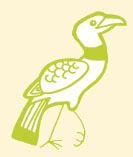
My grandparents lived in a semi-forested area on the edge of a tiny town in central Oklahoma. The dining room featured a big picture window overlooking a yard that backed onto unkempt woodland. Near the window there was a pair of binoculars and a bird book. There were birdfeeders, three different bird baths out back (two in the front). The yard, fields and forest were dotted with little birdhouses that Grandpa made himself. They were all identical - smallish, grey-blue with a red roof on top. Most of them were on poles unceremoniously strewn about the property, and as memory serves they were almost exclusively occupied by phoebes. Year after year.
Mom had birdfeeders of her own, a bird bath, binoculars and her own bird book. Though I don't remember much identification occurring at our house, there was a great deal of interest in the ducks at the duck-pond park, the guinea hens who inexplicably resided there, the grackles that were so loud by the swing set.
So I knew a bit about birds. I couldn't help it. I was surrounded by people that would point to something at the feeder and identify it. Over time I knew the names of certain birds. But I didn't understand how profound Mom's gift really was until one day when I was about five or six. We were sitting out on the back deck and Grandpa's in the morning. Something flew over our heads and into a tree. She mentioned in passing what it was, and I was stunned. How could she know that? It passed by so fast!
This was before I knew about tell-tale flight patterns, or distinctive songs (nothing but a jay sounds like a jay, with those loud, raspy cries), or that a flash of red in Oklahoma is almost certainly a cardinal, particularly if there's a pair of them that have been hanging around the feeders all morning. All I knew is my mother had some sort of magical powers of observation. And I wanted those powers.
I went inside for a piece of paper and pencil and asked her to list all of the birds that she saw. I wrote down the name of everything she said, and put a tally mark next to subsequent sightings. Cowbird, phoebe, sparrow, purple martin, blue jay, cardinal, chickadee, scissor-tail flycatcher... I'd had no idea there could be this many different kinds of birds in a place at once.
I have been an avid amateur ornithologist ever since.
I suppose it's the artist's eye that seduces one so easily into this sort of thing. The natural eye for detail, the desire to receive as MUCH information as possible with a glance, the sense of relief that comes from identification -- a mystery solved. Then too, identification of an individual species in a crowd of many allows you to keep track of them, to enjoy the unfolding drama before your eyes.
Maybe it doesn't need explanation. Maybe it was simple upbringing. My grandfather watched birds, he taught his children, and they taught theres. It was a thing to bond over, a thing to learn to feel a part of the group, and now it's a simple pleasure all its own that I am slowly teaching Anthony.
Birdwatching (bird identifying, anyway,) is often a game of knowing little tricks. You very rarely get a textbook view of something, so you have to know a lot of little things about birds. The strange swooping flight pattern of a scrub jay. The flashes of white and black signaling a junco darting for the underbrush. Knowing the difference between a vulture's wings at a distance (open, like a capital letter V) vs. an eagle's (flat, like a -).
All was well until I moved to Portland, where most of the birds worth seeing hide a WAY up the tops of trees. Time of day and general quietness helps, (as do walks in designated 'bird areas', where I've seen some extraordinary sights,) but there have also been many walks in Forest Park featuring a cacophony of sound and not a single sighting.
Because of this I have begun to think about birding from a completely different angle -- that of sound. At long last I have got my hands on a copy of Roger Tory Peterson's Birding By Ear, a three disc CD set designed to teach that notoriously difficult (for me) practice of discerning birdsong.
Within the introduction there are several suggestions as to how one might go about "facilitating learning", which is possibly my most favorite phrase. I do so love to facilitate the learning. I listen to it in bursts, (too much at once and they all start sounding the same again). Already it helped me spot a pileated woodpecker a few weekends ago.
Learning: facilitated.
.


